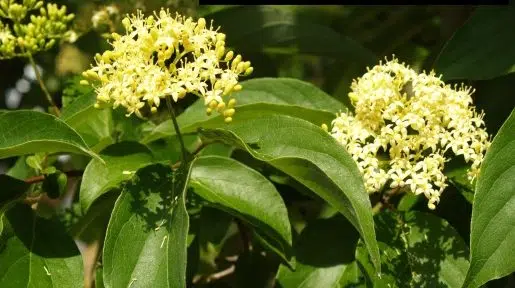Trees
Fall Color

Looking for something in particular? Click here to search.


Acer saccharum
Sugar maple
Renowned for its autumn color, sugar maples are perhaps the most magnificent shade trees in northeastern Ohio. Sugar maple interbreeds with black maple which shares much of its native range.... more

Acer x freemanii ‘Autumn Fantasy’ (Freeman maple)
According to Klyn Nursery, “Being a Freeman maple, the ‘Autumn Fantasy’ is a hybrid of Acer rubrum and A. saccharinum resulting in A. rubrum’s strong branch structure and A. saccharinum’s fast growth. The ‘Autumn Fantasy’ really takes this to heart with an improved... more

Nyssa ‘Tupelo Tower’
Nyssa ‘Tupelo Tower’ (black gum)
This selection has a very tight, upright habit unlike the species. The lustrous dark green summer foliage turns impressive shades of orange in early fall. The upright narrow habit is ideal for smaller... more

Ginkgo biloba ‘Princeton Sentry’
Ginkgo biloba ‘Princeton Sentry’ (gingko)
‘Princeton Sentry’ is an all-male cultivar with an upright, narrowly conical habit. Leaves turn a uniform golden yellow in autumn and persist for several weeks. When the leaves do drop,... more

Carya laciniosa
Carya laciniosa (shellbark hickory)
Shellbark hickory, a.k.a. kingnut is native from western New York to Iowa, south to Georgia and Texas. Although widely distributed, it is not common, certainly not in Holden’s natural areas... more

Acer rubrum ‘Bowhall’
Acer rubrum ‘Bowhall’ (red maple)
According to Klyn Nursery, “A columnar red maple! Narrower when young, this tree becomes a broad column at maturity with a spread ranging from 18–25’. Green foliage turns yellow-orange to reddish-orange in fall. ‘Bowhall’ can be used as a shade... more

Acer rubrum ‘Brandywine’
Acer rubrum ‘Brandywine’ (red maple)
According to Klyn Nursery, “Introduced by the U.S. National Arboretum, the ‘Brandywine’ is a selection from the native species Acer rubrum. It forms an upright, oval crown as it matures but does not... more

Quercus glandulifera
Quercus glandulifera (Konara oak)
Acoording to Klyn Nursery, “Native to Japan, Korea, and China, this oak is extremely rare in cultivation. The shiny leaves have slight serrations on the edges and are a perfect background for... more

Malus ‘Perfect Purple’
Malus ‘Perfect Purple’ (crab apple)
Perfect Purple is an upright crab apple variety featuring purple leaves and bright pink blooms in spring. In fall, the leaves turn bright red and complement the small, red to purple fruit. Fruit is persistent and remains on the... more

Stewartia koreana ‘Milk and Honey’
Korean stewartia
Stewartias are prized garden plants across the world. White, camellia-like summer flowers. Exceptional fall color. Fascinating bark. A small tree for all seasons. Bark should be more subtle than ‘Ballet’ but fine nonetheless. Grown in... more

Stewartia pseudocamellia ‘Ballet’
Japanese stewartia
Stewartias are prized garden plants across the world. White, camellia-like summer flowers. Exceptional fall color. Fascinating bark. A small tree for all seasons. Grown in full sun they stay squat. In shade... more

Quercus shumardii
Shumard oak
Shumard oak is a medium sized, deciduous tree in the red oak group. It performs well in full sun, average soil and tolerates a variety of moisture conditions. Pyramidal in youth but spreads to a... more

Cornus drummondii ‘Lemon Drop’
Grey dogwood
The dogwood selection is easily grown in a wide range of soils in full sun to part-shade. In late summer and early fall the fruit develop into clear yellow that contrast nicely against... more

Aesculus flava
Yellow buckeye
Yellow buckeye is the largest of the buckeyes. It has an irregular to upright-oval crown and is considered a canopy tree. If left to achieve its natural form, the sturdy branches will commonly sweep the ground. The bark often exfoliates with... more

Acer x freemanii ‘Celebration’
Freeman’s Maple
The selection has a contoured, upright, uniform branching structure with a good central leader and rarely requires pruning to maintain its naturally symmetrical form. It’s known for being disease resistant, tolerant of urban pollution... more

Cladrastis kentukea
American yellowwood
Cladrastis (klad-RAS-tis) kentukea is a very uncommon yet beautiful tree first discovered in the Cumberland region of Tennessee by French botanist André Michaux in 1796. It may still be found... more

Acer palmatum
Japanese maple
A beautiful small tree with gorgeous foliage and refined habit, Japanese maple is prized by landscape designers from east to west. The native range of Acer palmatum includes the islands... more


Fagus sylvatica
European Beech
Fagus sylvatica is a magnificent tree. European beech is native from the southern parts of Sweden and Norway to Spain, Italy, Greece and northeast Turkey and Ukraine. It is a common... more



Aesculus parviflora
Bottlebrush Buckeye
Aesculus parviflora, bottlebrush buckeye is my favorite shrub. It is a native of the southeastern United States, primarily to Alabama. The genus Aesculus and the maples, Acer, recently have been lumped into the... more

People for Trees™
Make a difference in
your own backyard.
Plant and care for a tree beginning with making a pledge. We will support each pledge with easy-to-follow instructional toolkits, guidance on how to select the most appropriate tree and where to purchase it, free virtual classes and other ongoing support.
Make a pledgeWhat can we help you find?
Popular searches:




